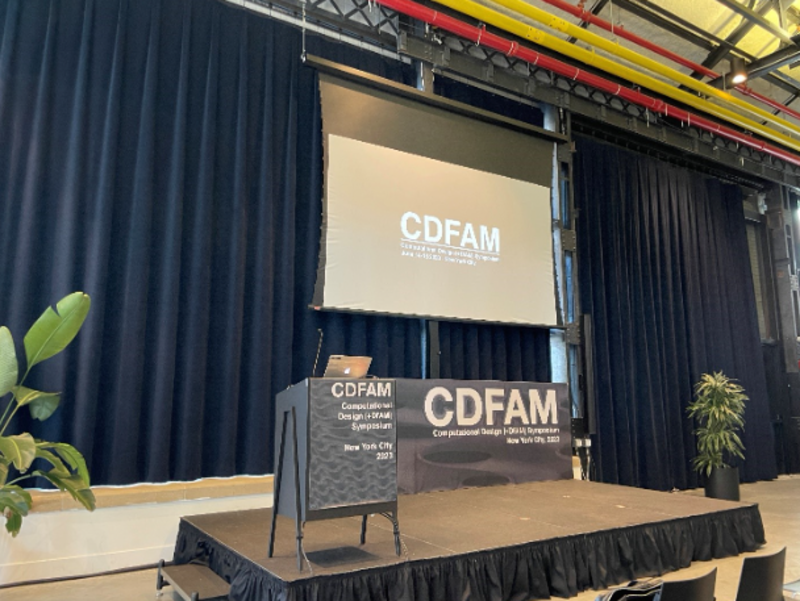If you’ve ever wished to be in a room full of industry experts at the forefront of computer-aided design software and artificial intelligence, Brooklyn Navy Yard was the place to be. The inaugural Computational Design Symposium (CDFAM) was held June 14-15 at Newlab, a converted warship manufacturing facility in New York City. Nearly 150 attendees gathered to hear speakers from NASA, MIT, Oak Ridge National Laboratory, and dozens of companies establish the state of the art in computational design software. Groundbreaking highlights covered everything from optimized egg cartons to aerospace brackets.
HP’s Nathan Shirley helped kick off the conference by detailing the company’s solution for molded fiber tooling. Molded fiber (or molded pulp) is used in a variety of consumer packaging applications but is exemplified by fast-food beverage carriers or egg cartons. Typically, molded fiber tooling uses a shaped metal mesh to strain water from pulp as it collects on the mold. HP’s process uses optimized, 3D-printed screens with dynamic hole sizing to adjust the amount of pulp in different part areas. This improvement results in a more efficient manufacturing process, but designing parts with thousands of small holes is computationally impractical for standard 3D design formats. So difficult, in fact, that HP partnered with Modelab to develop an entirely new digital design pipeline that uses voxel-based algorithms to generate the mold designs.
NASA’s Ryan McClelland showed that computational design software isn’t just changing part designs, it’s changing the design process itself. He presented a side-by-side comparison of his team’s design workflow for an aerospace bracket with and without using generative AI software. First, his team used traditional computer-aided design methods to iterate and improve the bracket over the course of two days until an acceptable solution was reached. Then, the team used generative AI software to design the same part. After one hour, the software had designed a part that was stronger, lighter, and less expensive to manufacture than the first bracket. Using a generative design solution not only saved the team time and money, but measurably shortened their design process.
A Tale of Two Roadmaps: Startups vs Corporations
We expect startups to disrupt industry standards and the younger companies at CDFAM did not disappoint. Companies such as nTop, Hyperganic, Metafold, and the non-profit 3MF Consortium all made compelling arguments to abandon the STL file format for newer solutions involving mesh-less approaches and implicit files. Modern 3D printing enables the manufacturing of complex micro-lattices and metamaterials, and standard digital formats struggle to keep up with the data types and fidelity required. Designing these structures in standard CAD software can generate files 10s of gigabytes in size that require professional workstations to open. The companies’ software demos showed lightning-fast lattice design and simulation, even offering browser and cloud-based design experiences. And in keeping with the year’s top trend, multiple companies demoed ChatGPT integrations that allow users to design complex structures using natural language inputs via a text box.
Industry veterans were skeptical of such text-based, generative-AI features and new file formats. Michael Smell detailed Autodesk’s generative-AI additions to its Fusion 360 platform. He noted that Autodesk had to develop tools based on industry demand and most of its customers continue to use the industry standard boundary representation (B-rep) modeling technology. Fusion 360’s generative design plug-in generates a file in this traditional format, one that engineers are used to and can be further edited with traditional CAD software. Supporting Autodesk’s approach was Chris McComb, the director of Carnegie Mellon’s Human+AI Design Initiative, who reiterated the importance of keeping the human element in the design process. In his social experiments with engineering teams, Chris determined that relying on AI design programs can reduce team performance in certain situations. Current software can’t yet compete with human creativity and agility when it comes to solving complex engineering design problems.
Looking Forward
Generative AI aside, the conference ended with a future-looking keynote from Neil Gershenfeld of MIT’s Center for Bits and Atoms. Neil discussed a roadmap for the next generation of fabrication using “digital materials,” which he compared to Legos. When Legos are assembled, geometry and accuracy are built into the individual blocks. It’s easy to determine when a Lego has been placed incorrectly and it can then be quickly disassembled and corrected. Neil wants to bring these benefits to the manufacturing industry for all material types and manufacturing approaches.
With the incredible range of possibilities enabled by improvements to design software and AI models, next year’s CDFAM would certainly be an event to look out for in the world of computational design innovations and applications. The event’s host, Duann Scott, closed the conference hopeful that next year would see the event’s return in light of this year’s success.
Shape the future of industrial 3D printing Join the conversation at Formnext Forum Austin, August 28-30, in Austin, Texas. Industrial AM innovation is the focus of the event, which is designed for industrial business leaders who want to further expand AM into their operations, as well as for those who want to evaluate AM as a production technology. It is also a place where engineers, researchers, and those who develop and apply AM technologies can exchange ideas that spur further innovations.
Register for Formnext Forum Austin to learn more at formnextforum.com. Use the discount code: FFAIMTS.





